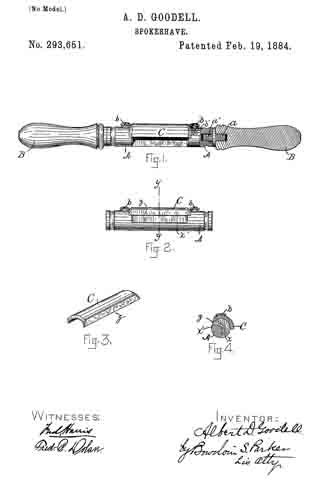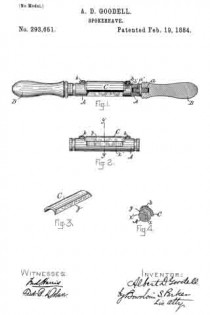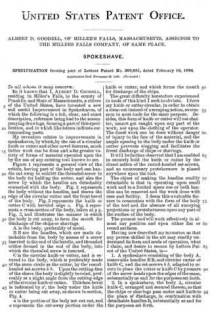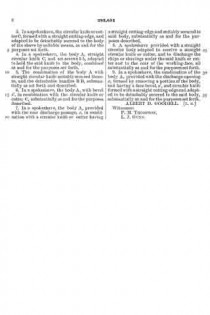No. 293,651 – Spokeshave (Albert D. Goodell) (1884)

UNITED STATES PATENT OFFICE.
_________________
ALBERT D. GOODELL, OF MILLER’S FALLS, MASSACHUSETTS, ASSIGNOR
TO THE MILLERS FALLS COMPANY, OF SAME PLACE.
SPOKESHAVE.
_________________
SPECIFICATION forming part of Letters Patent No. 293,651, dated February 19, 1884.
Application filed November 30, 1883. (No model.)
_________________
To all whom it may concern:
Be it known that I, ALBERT D. GOODELL., residing in Miller’s Falls, in the county of Franklin and State of Massachusetts, a citizen of the United States, have invented a new and useful Improvement in Spokeshaves, of which the following is a full, clear, and exact description, reference being had to the accompanying drawings, forming a part of this specification, and in which like letters indicate corresponding parts.
My invention relates to improvements in spokeshaves, by which, by the use of a circular knife or cutter and other novel features, much better work can be done and a far greater variety of forms of material operated upon the by the use of any existing tool known to me.
Figure 1 represents a general view of the article, having part of the body and one handle cut away to exhibit the threaded screw in the body for holding the cutter, and also the screw by which the handles are detachably connected with the body. Fig. 2 represents the body without the handles, and shows the edge of the circular cutter and the front bevel of the body. Fig. 3 represents the knife or cutter C with beveled edge z. Fig. 4. represents a cross-section of the body, taken at y y, Fig. 2, and illustrates the manner in which the body is cut away, to form the mouth for discharge of the chips or shavings.
A is the body, preferably of metal.
B B are the handles, which are made detachable from the body by means of a screw inserted in the end of the handle, and threaded orifice formed in the end of the body, into which the threaded screw is inserted.
C is the circular knife or cutter, and is secured to the body, which is preferably made of the same circle as the cutter, by the round-headed set-screws b b. Upon the cutting-face of the shave the body is slightly beveled, preferably at a slight angle from the cutting-edge of the circular knife or cutter. This face-bevel is indicated by x’, the body under the knife or cutter being cut away, as shown in section, Fig. 4.
a is the portion of the body not cut out, and as represents the cut-away portion under the knife or cutter, and which forms the mouth for discharge of the chips.
The great difficulty heretofore experienced in tools of this kind I seek to obviate. I form my knife or cutter circular, in order to obtain a clean out instead of a scraping action, so common to most tools for the same purpose. Besides, this form of knife or cutter will not chatter, cannot get caught upon any part of the work, nor upon the clothing of the operator. The finest work can be done without danger of injury to the face of the material, and the ample opening in the body under the knife or cutter prevents clogging and facilitates the freest discharge of chips or shavings.
It will be further observed that I am enabled to securely hold the knife or cutter by the direct action of the round-headed set-screws, and no unnecessary protuberance is placed anywhere upon the tool.
The object of making the handles readily detachable is that in operating upon small work and in a limited space one or both handles can be removed and the work done with ease and facility. I deem this avaluable feature in connection with the form of the body of the tool and the absence of all annoying projections or protuberances upon any part of the surface of the body.
The present tool will work effectively in almost any position and upon either flat or round surfaces.
Having now described my invention so that any person skilled in the art may readily understand its form and mode of operation, what I claim, and desire to secure by Letters Patent of the United States, is —
1. A spokeshave consisting of the body A, removable handles B B, and circular cutter or knife C, and the set-screws b b, adapted to secure in place the cutter or knife C by pressure of the screw-heads upon the edges of the same, substantially as and for the purposes set forth.
2. In a spokeshave, the body A, circular knife C, arranged and secured thereto, so that the chips or shavings pass under said knife to the place of discharge, in combination with detachable handles B, substantially as and for the purposes set forth.
3. In aspokeshave, the circular knife or cutter C, formed with a straight cutting-edge, and adapted to be detachably secured to the body of the shave by suitable means, as and for the purposes set forth.
4. In a spokeshave, the body A, straight circular kniie C, and set-screws b b, adapted to hold the said knife to the body, combined as and for the purposes set forth.
5. The combination of the body A with straight circular knife suitably secured thereto, and the detachable handles B B, substantially as set forth and deseribed.
6. In a spokeshare, the body A, with bevel x’, in combination with the circular knife or cutter C, substantially as and for the purposes described.
7. In a spokeshave, the body A, provided with the rear discliarge-passage, x, in combination with a circular knife or cutter having a straight cutting-edge and suitably secured to said body, substantially as and for the purposes described.
8. A spokeshave provided with a straight circular body adapted to receive a straight circular knife or cutter, and to discharge the chips or shavings under the said knife or cutter and to the rear ofthe working-face, all substantially as and for the purposes set forth.
9. In a spokeshave, the cornbination of the body A, provided with the discharge-opening x, formed by removing a portion of the body, and having a face-bevel, x’, and circular knife formed with a straight cutting-edge and adapted to be detachably secured to the said body, substantially as and for the purposes set forth.
ALBERT D. GOODELL [L. S.]
Witnesses:
F. M. THOMPSON,
L. J. GUNN.



